
Parsi funerals are among the world’s most unique and spiritually significant ceremonies. Rooted in the ancient traditions of Zoroastrianism, they reflect the community’s deep respect for nature, purity, and the afterlife. Unlike many cultures that practice burial or cremation, Parsis follow a distinct ritual known as ‘Dokhmenashini’—a method of disposing of the deceased that aligns with their religious beliefs.
Let’s look into the depth of Parsi funerals and understand what to do and not do at Parsi Funerals.
The Philosophy Behind Parsi Funerals
The Zoroastrian faith, one of the world’s oldest religions, places immense emphasis on the elements of nature—earth, water, fire, and air. According to Zoroastrian teachings, death is a form of contamination. When a person dies, their body is believed to be invaded by ‘Druj Nasu,’ or the demon of decay. To prevent this contamination from spreading, Zoroastrians avoid traditional burial or cremation, as both methods would defile sacred elements: earth (if buried) and fire (if cremated). Instead, they practice sky burial, which allows the body to return to nature in the purest form.
See Also: Muslim Funeral Tradition and Etiquettes
The Rituals Leading to the Final Journey
1. The ‘Sarosh’ Ceremony
As soon as a Parsi passes away, family members notify a priest and undertake the ‘Sarosh’ prayer, seeking protection for the soul’s transition. The deceased is bathed and clothed in a simple, white muslin garment called the ‘Sudreh,’ which signifies purity. The head is covered with a white cap, and the body is placed on a prayer bed with a lamp lit beside it.
Sagdid is a key ritual in Zoroastrian funeral customs. The term translates to “glance of the dog,” with sag meaning “dog” and did meaning “to see.” This practice involves bringing a sacred dog near the deceased to confirm death before anyone else touches the body. The ritual is believed to purify the surroundings, reduce the risk of contamination, and ensure the individual has truly passed away.
2. The ‘Geh Sarna’ Ceremony
Before the funeral procession, a ritual called ‘Geh Sarna’ is performed. During this ceremony, priests recite prayers from the Avesta (Zoroastrian scriptures), which are meant to guide the soul towards the afterlife. Close family members sit around the deceased, offering prayers and seeking blessings.
3. The Funeral Procession
On the day of the funeral, two designated pallbearers, known as ‘Nasasalars,’ prepare the body for its final journey. These individuals follow strict purification rituals before and after handling the deceased. They carry the body on a special bier, walking in silence towards the Tower of Silence. No family members are allowed to touch the body after death, as it is considered impure.
During the procession, relatives and friends follow in a solemn walk, reciting prayers but maintaining complete silence. It is believed that excessive weeping or wailing may disturb the soul’s transition.
See Also: Christian Funeral Traditions & Manners
The Tower of Silence: A Sacred Resting Place
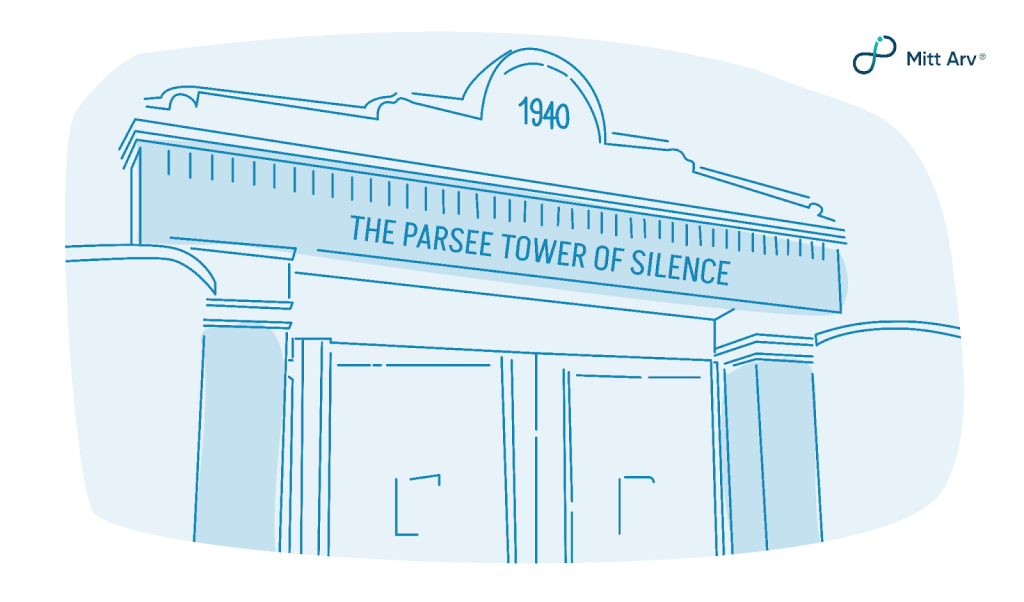
The most distinctive feature of Parsi funerals is the ‘Dakhma,’ commonly known as the Tower of Silence. This is a circular, open-air structure built on an elevated landmass, away from human habitation. It is designed to expose the deceased to the elements and scavenging birds, mainly vultures, which facilitate the process of excarnation (removal of flesh). The bones are later dried by the sun and eventually disintegrate into dust, returning to the earth without polluting it.
The Tower of Silence is divided into three concentric rings:
- The outermost ring is for men.
- The middle ring is for women.
- The innermost ring is for children.
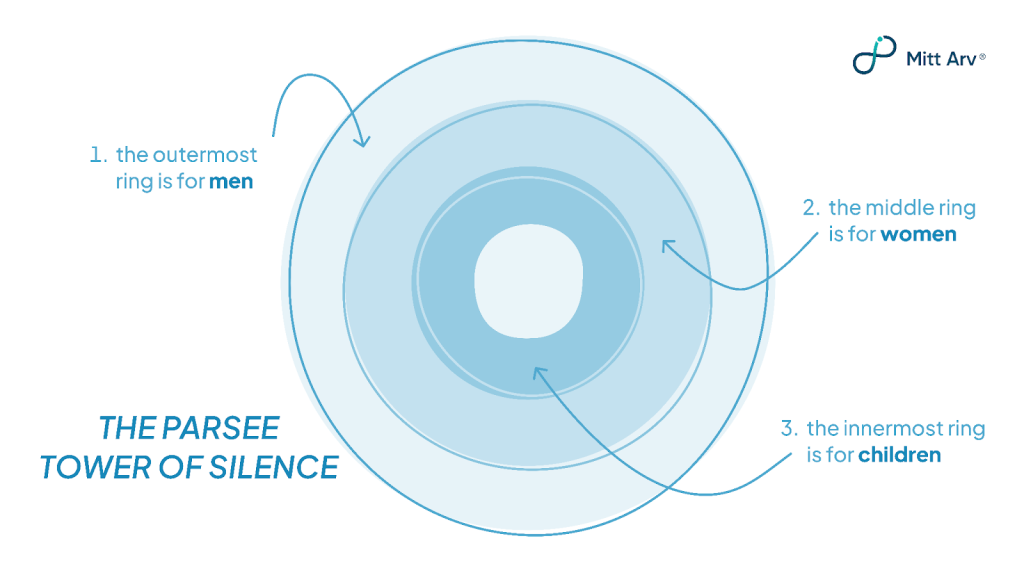
This segregation is based on traditional Zoroastrian customs. The entire process is guided by the belief that the body must be disposed of in a way that does not defile nature.
See Also: How to pay Respect at Sikh Funerals
The Final Goodbye
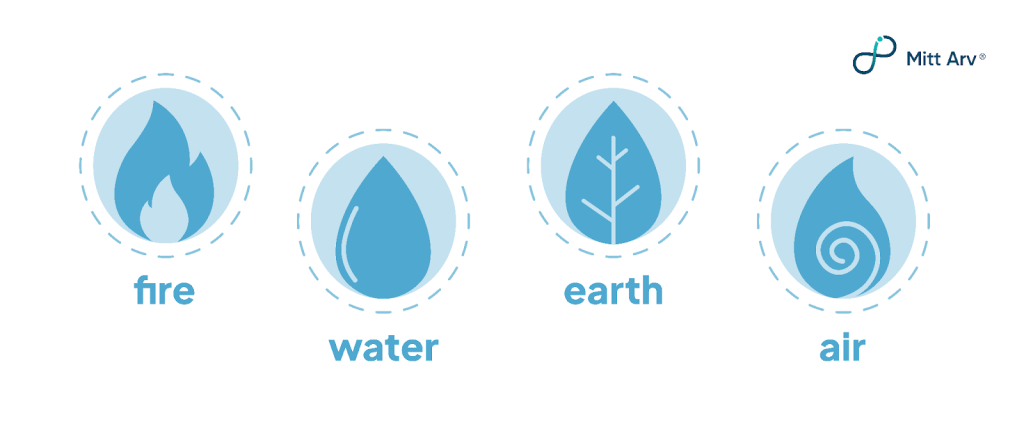
Once the body reaches the Tower of Silence, the Nasasalars place it in its designated ring. The vultures quickly consume the flesh, a process that traditionally took only a few hours. However, due to the decline in vulture populations in recent years, alternative methods such as solar reflectors (which speed up decomposition), have been introduced.
After the body is reduced to bones, natural elements further decompose them over time. This entire process is considered the most eco-friendly and spiritually pure method of returning the dead to nature.
However, some Parsi communities have had to explore alternative methods due to the fluctuating vulture population. Solar concentrators, which use mirrors to speed up the decomposition process, and enclosures to protect the remains from scavengers have been introduced in certain areas. These adaptations attempt to uphold tradition while addressing modern ecological concerns.
What Happens After the Funeral?
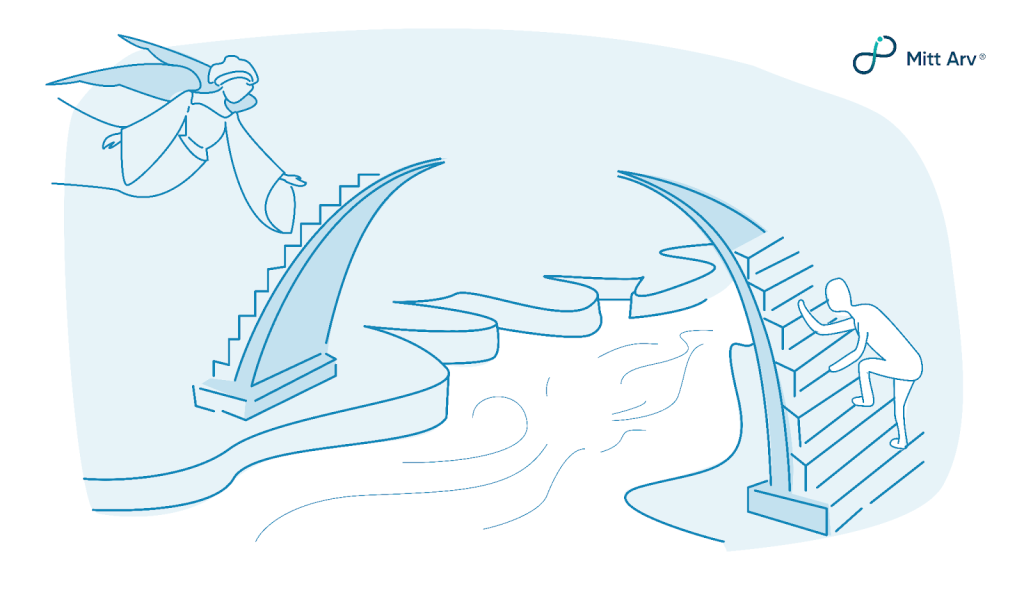
The mourning period in Parsi tradition lasts for four days. It is believed that during these days, the soul remains close to the physical world before departing to the spiritual realm. To assist in this journey, family members perform several rituals:
- Uthamna Ceremony: Held on the third day after death, this ceremony is a communal prayer session where priests recite sacred verses to guide the soul toward the afterlife.
- Chaharum Ceremony: On the fourth day, prayers are offered to confirm the soul’s transition. According to Zoroastrian beliefs, the soul crosses the Chinvat Bridge after four days—a mythical bridge that leads to the afterlife. If the person led a righteous life, the bridge widens, leading them to paradise. If not, the bridge narrows, leading them to a place of suffering.
- Annual Remembrance: Families continue to remember their loved ones through annual prayer gatherings, where offerings are made to commemorate their soul’s journey.
Do’s and Don’ts of Parsi Funerals
Do’s
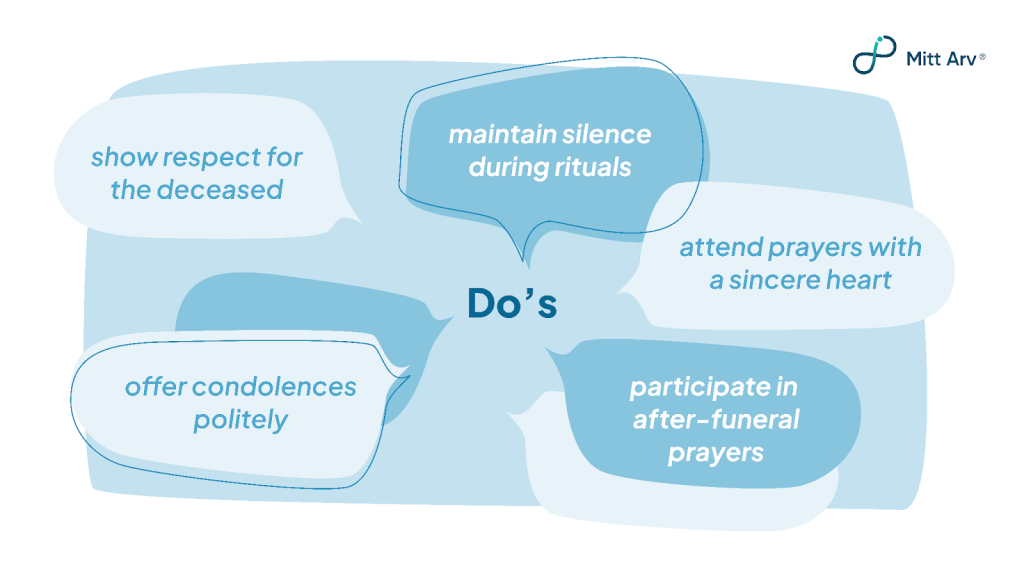
- Show Respect for the Deceased – Dress modestly in white or light-colored clothes and maintain a solemn demeanor.
- Attend Prayers with a Sincere Heart – Join the family in offering prayers, and if unfamiliar, observe respectfully.
- Follow Funeral Etiquette – Listen carefully to the instructions provided by the family or priests to maintain the decorum of the ceremony.
- Offer Condolences Politely – Express your condolences with simple words like “May their soul rest in peace” or “May they find eternal happiness.”
- Support the Bereaved Family – If close to the family, offer emotional and practical support.
- Maintain Silence During Rituals – Parsi funeral rites are deeply spiritual, so avoid unnecessary conversations.
- Observe the Sacred Fire – Fire is central in Zoroastrianism; if there is a fire urn or lamp at the ceremony, show reverence.
- Participate in After-Funeral Prayers – Several ceremonies, like the ‘Uthamna’ prayers, are held in the following days. Attending them is a sign of respect.
Don’ts
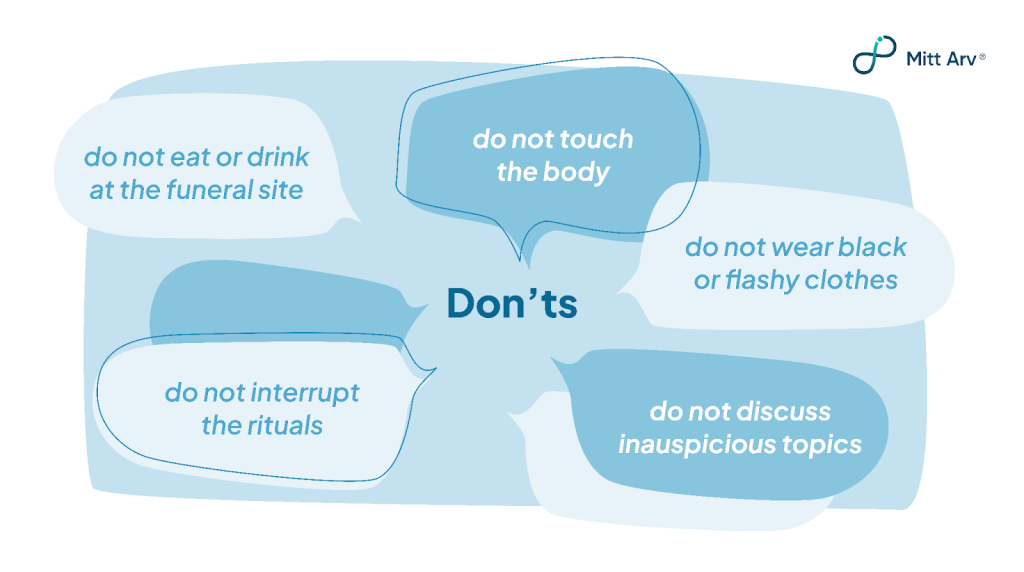
- Do Not Touch the Body – Only designated funeral custodians and priests handle the deceased.
- Do Not Take Photos or Videos – Funerals are private and sacred events; capturing images is considered disrespectful.
- Do Not Wear Black or Flashy Clothes – Unlike other cultures where black is a mourning color, Parsis prefer white or light-colored clothing as a symbol of purity.
- Do Not Bring Flowers – Unlike many other funerals, floral offerings are not a tradition in Parsi rites.
- Do Not Interrupt the Rituals – The ceremonies are performed with specific religious chants and prayers; interrupting them is frowned upon.
- Do Not Discuss Inauspicious Topics – Avoid conversations about property disputes, family tensions, or any negative topics.
- Do Not Eat or Drink at the Funeral Site – The Tower of Silence is a sacred place; eating and drinking there is strictly prohibited.
- Do Not Offer Condolences Excessively – While offering sympathy is important, avoid overdoing it to prevent causing additional grief.
The Essence of Parsi Funerals
Parsi funerals remain one of the most distinctive and ecologically sustainable traditions in the world. The emphasis on purity, respect for nature, and the spiritual journey of the soul is what sets this tradition apart.
For Parsis, death is a sacred journey where the soul moves towards Ahura Mazda, the supreme divine force. The rituals, prayers, and community support ensure that this transition is peaceful and in harmony with the core principles of Zoroastrianism.